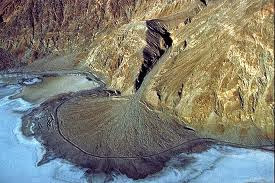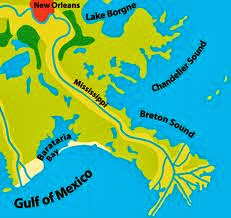Deltas
Deltas are the result of interacting fluvial (river) and, usually, marine systems. However, they can form anywhere a stream flows into shallower open water.
Whence the name Delta? Delta was coined by Herodotus (the father of history, 484-425 BC) after the Greek letter delta because of the deltoid-shape at the mouth of the Nile.
Delta definition: Coastal accumulations, both subaqueous and subaerial, of river-derived sediments adjacent to, or in close proximity to, the source stream, including the deposits that have been secondarily molded by various marine agents, such as waves, currents, or tides.
Deltas occur throughout the world, except at the poles (see slides). They all have three characteristics in common:
1. The presence of a large catchment, or drainage, basin (the area where all run-off water drains to the river). The top 30 river deltas all have catchment basins in excess of 1,000,000 sq km.
2. They all are at the mouth of large river systems that carry large quantities of clastic sediments (soils or portions of rocks that have been moved by water from where they formed).
3. They are not near geologically active coastlines. In order to have a large catchment basin, a very complex tributary system is necessary. These long, complex systems take a long time to develop, so they are very rarely situated on tectonically active coasts.
Parts of a Delta
A delta is comprised of four distinct regions: the subaqueous, subaerial, lower delta plain and upper delta plain.
Subaqueous – This is the portion of the delta that remains below the low tide mark. It is comprised of very fine silt that decreases in size the further away from the mouth of the river you get.
Subaerial – This area is above the low tide mark and consists of various sized sand and rock that is constantly in flux due to the actions of the tidal force.
Lower Delta Plain – This is where the river water flows into the larger body of water. Silt deposit formations are subject to both river current and tidal forces.
Upper Delta Plain – This is the starting point of the delta, and the silt here consists of the largest particles. There is relatively little impact from the large body of water or its forces here.
TYPES OF DELTAS:
1. Arcuate (fan-shaped) delta Nile River. Has many active, short distributaries taking sediment to their mouths. The receiving (ambient) waters are rather shallow and have relatively even wave action arriving perpendicular to the shore with minimal longshore current. As the sediment exits the many distributary mouths, the waves push it back, so the coastline is rather smooth.
Bird-foot (shaped like a bird foot) delta Mississippi River. Tend to have one or a very few major distributaries near their mouths. The receiving basin has currents that carry the sediment away as it exits the distributary mouth. There is a broad, shallow shelf that deepens abruptly, so the trend is to grow long and thin like a bird's toe.
Delta Life Cycle
A delta will either eventually reach a state of equilibrium between river deposits and tidal forces or will enter a cycle of progradation and transgression in which it grows and recedes based on the cyclical nature of the river system (i.e. floods, spring river runs, etc.).
Stagnate – This is the term for a delta that has reached equilibrium.
Prograde – A prograde delta is one in which the depositing of silt outweighs the tidal force dragging it away. These deltas grow outward into the large body of water until equilibrium is achieved.
Aggrade – An aggradation occurs when the delta starts to accumulate biomass. This can be from plant growth or from the collection of decaying organic material collected from the tides. These deltas grow upwards instead of outwards.
Transgression – A delta in transgression is receding from the sea. The tidal force is stronger than the river and thus pulls away more silt than is being deposited.
Where a river delta begins and where it ends are always approximations. To determine what is a river delta and what is not would require consistent monitoring of silt deposits. Because this is impractical, the area that is considered the beginning of a delta usually is determined by the coastline surrounding the river while the end of the delta is determined by the reach of the sediment deposits at low tide.
Of course, these are just estimates and the lower delta plain almost always extends past the low tide region, but there is no way to determine where it ends and the sea floor begins. There is simply a transitional area. In any case, the important thing is that the river delta is a transitional space between the river and the larger body of water.
Deltas are the result of interacting fluvial (river) and, usually, marine systems. However, they can form anywhere a stream flows into shallower open water.
 |
| Nile Delta |
Whence the name Delta? Delta was coined by Herodotus (the father of history, 484-425 BC) after the Greek letter delta because of the deltoid-shape at the mouth of the Nile.
Delta definition: Coastal accumulations, both subaqueous and subaerial, of river-derived sediments adjacent to, or in close proximity to, the source stream, including the deposits that have been secondarily molded by various marine agents, such as waves, currents, or tides.
Deltas occur throughout the world, except at the poles (see slides). They all have three characteristics in common:
1. The presence of a large catchment, or drainage, basin (the area where all run-off water drains to the river). The top 30 river deltas all have catchment basins in excess of 1,000,000 sq km.
2. They all are at the mouth of large river systems that carry large quantities of clastic sediments (soils or portions of rocks that have been moved by water from where they formed).
3. They are not near geologically active coastlines. In order to have a large catchment basin, a very complex tributary system is necessary. These long, complex systems take a long time to develop, so they are very rarely situated on tectonically active coasts.
Parts of a Delta
A delta is comprised of four distinct regions: the subaqueous, subaerial, lower delta plain and upper delta plain.
Subaqueous – This is the portion of the delta that remains below the low tide mark. It is comprised of very fine silt that decreases in size the further away from the mouth of the river you get.
Subaerial – This area is above the low tide mark and consists of various sized sand and rock that is constantly in flux due to the actions of the tidal force.
Lower Delta Plain – This is where the river water flows into the larger body of water. Silt deposit formations are subject to both river current and tidal forces.
Upper Delta Plain – This is the starting point of the delta, and the silt here consists of the largest particles. There is relatively little impact from the large body of water or its forces here.
TYPES OF DELTAS:
1. Arcuate (fan-shaped) delta Nile River. Has many active, short distributaries taking sediment to their mouths. The receiving (ambient) waters are rather shallow and have relatively even wave action arriving perpendicular to the shore with minimal longshore current. As the sediment exits the many distributary mouths, the waves push it back, so the coastline is rather smooth.
 |
| Delta forming |
 |
| Delta anatomy |
 |
| Nile river delta |
 |
| small scale delta |
 | |
|
 |
| Mississippi delta map |
 |
| Sacramento Delta at flood stage |
 |
| satellite image for foot bird delta |
Delta Life Cycle
A delta will either eventually reach a state of equilibrium between river deposits and tidal forces or will enter a cycle of progradation and transgression in which it grows and recedes based on the cyclical nature of the river system (i.e. floods, spring river runs, etc.).
Stagnate – This is the term for a delta that has reached equilibrium.
Prograde – A prograde delta is one in which the depositing of silt outweighs the tidal force dragging it away. These deltas grow outward into the large body of water until equilibrium is achieved.
Aggrade – An aggradation occurs when the delta starts to accumulate biomass. This can be from plant growth or from the collection of decaying organic material collected from the tides. These deltas grow upwards instead of outwards.
Transgression – A delta in transgression is receding from the sea. The tidal force is stronger than the river and thus pulls away more silt than is being deposited.
Where a river delta begins and where it ends are always approximations. To determine what is a river delta and what is not would require consistent monitoring of silt deposits. Because this is impractical, the area that is considered the beginning of a delta usually is determined by the coastline surrounding the river while the end of the delta is determined by the reach of the sediment deposits at low tide.
Of course, these are just estimates and the lower delta plain almost always extends past the low tide region, but there is no way to determine where it ends and the sea floor begins. There is simply a transitional area. In any case, the important thing is that the river delta is a transitional space between the river and the larger body of water.










No comments:
Post a Comment